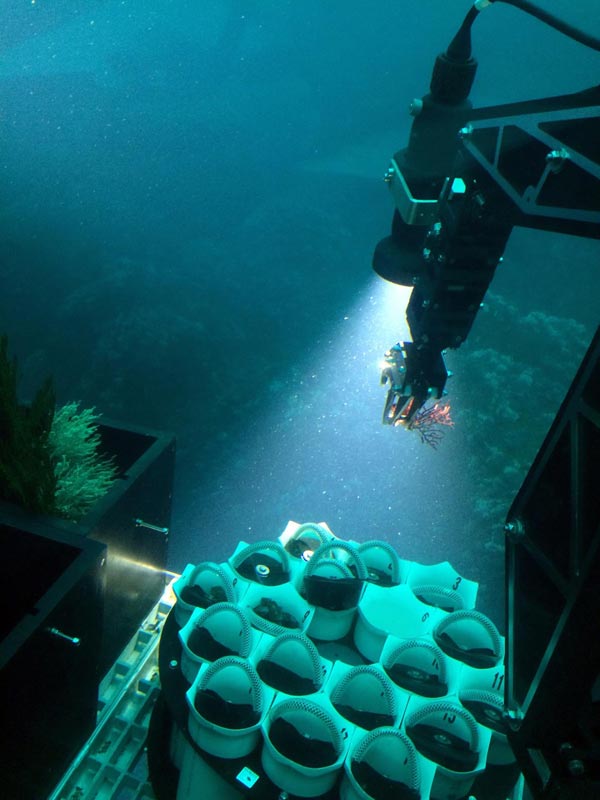New soft coral species discovered in Panama

DeepSea submersible collects coral sample. Credit: Hèctor Guzmán, STRI
Scientists established the new species, Thesea dalioi, by comparing its physical traits, such as branch thickness and the bright red colony color, with the only other species in the genus in the eastern Pacific, T. variabilis.
T. dalioi is named for Ray Dalio, a supporter of marine exploration. Its name is intended to recognize Dalio's valuable contributions to marine research and public outreach. Hannibal Bank, part of the Coiba National Park and a UNESCO World Heritage Site, is a coastal seamount and a biodiversity hot spot that has only been explored recently.
“After just two expeditions using submersibles down to 300 meters, we have identified 17 species of octocorals for the Hannibal Bank, including the discovery and description of three new species,” said Hector M. Guzman, marine ecologist at STRI and one of the authors of the study.
Light-dependent coral and algae, as well as other life-forms found in low-light environments, live on mesophotic reefs: meso means middle and photic means light. These reefs, such as the one where T. dalioi was found, are considered fragile habitats with a high diversity of corals, algae and sponges.
They are also generally neglected in most environmental and conservation policies because they are difficult to reach. Hannibal Bank is one of the spots requiring more attention for its protection.
“The present study should provide the basis for further research on the genus and contributes to the diversity and distribution knowledge of octocorals from the mesophotic zone in the eastern Pacific Ocean,” said Odalisca Breedy, marine biologist at CIMAR and one of the authors of the study.
“Medical researchers have identified therapeutic benefits derived from both soft and hard corals such as anti-inflammatory and anti-cancer properties, bone repair and neurological benefits,” said Guzman. “But our ability to contribute to the understanding of soft corals and their habitats, depends not only on steady funding for the use of submersibles, but also on our continued ability to obtain permission to work in Coiba National Park.”
###
The Smithsonian Tropical Research Institute, headquartered in Panama City, Panama, is a unit of the Smithsonian Institution. The Institute furthers the understanding of tropical biodiversity and its importance to human welfare, trains students to conduct research in the tropics and promotes conservation by increasing public awareness of the beauty and importance of tropical ecosystems. Website. Promo video.
Reference: Breedy, O..; Guzman, H. M. (2018): A new alcyonacean species (Cnidaria: Anthozoa: Octocorallia) from a seamount in the tropical Pacific Ocean. In: Bulletin of Marine Science. DOI: 10.5343/bms.2018.0027
Media Contact
All latest news from the category: Life Sciences and Chemistry
Articles and reports from the Life Sciences and chemistry area deal with applied and basic research into modern biology, chemistry and human medicine.
Valuable information can be found on a range of life sciences fields including bacteriology, biochemistry, bionics, bioinformatics, biophysics, biotechnology, genetics, geobotany, human biology, marine biology, microbiology, molecular biology, cellular biology, zoology, bioinorganic chemistry, microchemistry and environmental chemistry.
Newest articles

NASA: Mystery of life’s handedness deepens
The mystery of why life uses molecules with specific orientations has deepened with a NASA-funded discovery that RNA — a key molecule thought to have potentially held the instructions for…

What are the effects of historic lithium mining on water quality?
Study reveals low levels of common contaminants but high levels of other elements in waters associated with an abandoned lithium mine. Lithium ore and mining waste from a historic lithium…

Quantum-inspired design boosts efficiency of heat-to-electricity conversion
Rice engineers take unconventional route to improving thermophotovoltaic systems. Researchers at Rice University have found a new way to improve a key element of thermophotovoltaic (TPV) systems, which convert heat…



